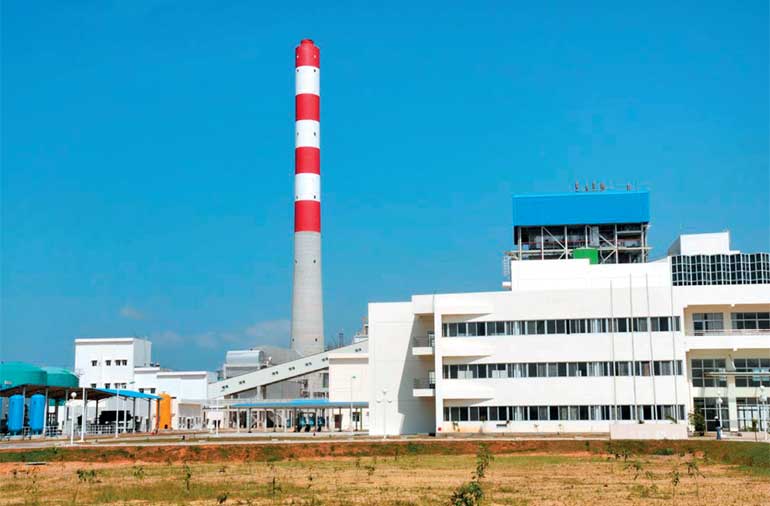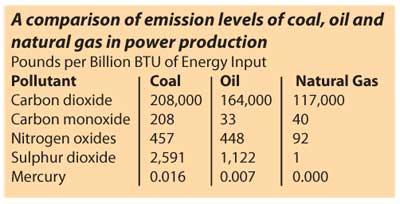Friday Nov 14, 2025
Friday Nov 14, 2025
Tuesday, 19 April 2016 00:10 - - {{hitsCtrl.values.hits}}
People of Sri Lanka who were accustomed to uninterrupted power were shocked by the recent power breakdowns. The power failure while the country going through an unprecedented heat wave was the worst since May 1996, when the entire country was without electricity for four days. Public fail to understand the CEB engineers’ inability to supply power, on a Sunday daytime, when most offices and factories are closed.
According to CEB, two power failures were due to explosions in two transformers in the distribution grid, which tripped the automatic mechanism of the Norochcholai Power Plant for its protection. When the coal power plant’s operation is halted, it takes nearly three days to cool down and re-commence operations.
But other sources claim three days for cooling is due to technical issues with equipment, design defects as cooling systems of the plant being powered by the same generator, delaying repairs until natural cooling bring down the plant temperature.
 The Norochcholai Power Plant functioned for years without any major maintenance due to the CEB’s dependence of the plant. According to the manufacturer, the plant should have been serviced on a regular basis
The Norochcholai Power Plant functioned for years without any major maintenance due to the CEB’s dependence of the plant. According to the manufacturer, the plant should have been serviced on a regular basis
Exploding transformers
Exploded transformers were located first in Biyagama exchange and second in Kotugoda. Biyagama and Kotugoda exchanges are links in the main transmission network converging power supplies from Kotmale (Victoria), Kotugoda (Kerawalapitiya and Puttalam), Kelanitissa and Pannipitiya. It later revealed that transformer that burst at Biyagama was of German origin and 30 years old and the Kotugoda transformer was last inspected on 31 December 2014, which queries CEB’s maintenance programme of their critical equipment.
With the power failure, the CEB “given the urgency of the current situation, is looking at either extending those agreements or purchasing the plants outright. They are looking at getting power from IPP’s ACE power plant Embilipitiya 100MW, ACE Matara – 25MW and Heladanawi Puttalam 100MW.”
Power generation situation
The country’s power generation capacity stand at 4,050MW and the maximum electricity demand is around 2,300MW. According to PUSL report for ‘First Half Generation Performance 2014,’ highest recorded peak demand was 2151.7MW on 19 May 2014. According to same report although the consumption was expected to increase around 5%, actual increase was lower. Therefore, even with a loss of 1,000MW due to drought and other reasons, engineers could comfortably maintain the system.
Energy development plan
In 2015, then Minister for Power and Energy, Patali Champika Ranawaka presented ‘Sri Lanka Energy Sector Development Plan for a Knowledge-based Economy, 2015-2025’. According to the report, country’s total installed power generation capacity amounts to 4,050MW consisting of 900MW from coal, 1,335 from oil burning thermal, 1,375 from hydro-power and 442 from non-conventional sources as wind, mini-hydro, bio-mass and solar power.
The plan proposes to increase generation capacity to 6,400MW by 2020, generate 1000MW of electricity using gas discovered in Mannar and convert existing thermal plants to natural gas; develop renewable power as bio-mass, mini-hydro, solar and wind-power to generate 1114MW. Also to achieve self-sufficiency in energy and produce entire petroleum requirement by 2025, based on gas from Mannar becoming available by 2020.
Future power
But according to ‘CEB – Development Planning on Optimal Power Generation for Peak Demand in Sri Lanka’ prepared in February 2015, the composition of power generation in 2025 would be coal thermal 73%, hydro power 19%, HCRE 7% and oil thermal 1%. The plan does not envisage use of gas from Mannar.
The power crisis
The first coal-based power plant which was proposed in the 1980s in Trincomalee was unacceptable due to security reasons. The next location, Mawella near Tangalle, by the deep-water harbour, was abandoned when locals protested. Next, Japanese consultants proposed Dungalpitiya in Negombo or Norochcholai. The latter involved ships anchoring 4km from shore and coal being brought to the plant in barges, costing an additional $ 120 million. CEB selected Norochcholai, was challenged by the Church and for over a decade  the project remained undecided.
the project remained undecided.
Meanwhile, power cuts in the early 1990s were manipulated by the CEB to purchase power from Private Power Developers (PPDs), leading to massive losses. Some power purchase agreements had committed CEB to purchase power at rates exceeding Rs. 30 per unit for over a period of 20 years. Purchase of power from PPDs continued till all stages of Norochcholai came into operation in 2014.
Design of coal-fired power plant
President Mahinda Rajapaksa decided to go ahead with Norochcholai with Chinese assistance with a MOU in 2004, and the purchase agreement was signed in September 2005. Construction of the facility began in May 2006, with the first unit commissioning on 22 March 2011.
The establishment of a coal-fired power plant was proposed in 1980s and the Government took two decades for implementation. The delay would have allowed CEB engineers to read, study, visit, discuss and understand technicalities of coal power projects in great detail.
Purchasing the power plant from China with funding was a political decision. China produces machinery of varying quality from cheap to high quality for the US and European markets. The purchase agreement was signed in September 2005 by the CEB General Manager and the President of Electrical Engineers’ Association. The year-long period allowed CEB and Chinese to discuss and agree on the technical specifications of the plant. CEB was assisted by a foreign consultant selected by the CEB.
Specifications for machinery
Large machinery or plants are not available for purchase over the counter and are specifically built for the customers’ requirements, referred as specifications. For a power generation plant specifications could be lengthy, would include details of material quality,  manufacture of components, installation, routine tests, tests in owner’s presence, spares, guarantees, etc.
manufacture of components, installation, routine tests, tests in owner’s presence, spares, guarantees, etc.
The CEB, having ordered and purchased equipment for diesel and hydro electricity generating plants for decades, would be conversant of the procedure. Although inexperienced in coal powered generators, had two decades to study and employed an experienced foreign consultant. During the manufacturing stage of the plant, there are consultants operating world-over including China, who track the manufacturing process and ensure that the plant is manufactured to client’s specifications. Thus Norochcholai Power Plant supplied by the Chinese was as per CEB requirement.
Operation of Norochcholai plant
The power plant was commissioned in 2011, six years after signing of the agreement, and faced several breakdowns during operation. In July 2012, the power plant was shut down due to a leak in one of the thousands of tubes in the boiler. The same problem reappeared just before Christmas 2013. On 8 August 2012, tripping of the power line from the plant caused the power station to cease operations. On 29 January 2013, the power generation of the plant exceeded its designed level of 300MW, causing a complete shutdown. On 13 March 2016, an island-wide power outage occurred, which caused the power plant to fail.
When completion of the plant got delayed, installation of the plant was hurried under political pressure, welding of thousands of boiler pipes was expedited and testing of welded pipes was overlooked. It was these welds that gave away during operation. CEB turned to the plant’s manufacturer CMEC for assistance. Years later when second and third power plants were commissioned, the Chinese replaced the defective boiler.
The excessive power generation in January 2013 resulted in plant stoppage; investigations showed carelessness of the operators, while the plant was operating at full capacity, one operator was sleeping and the other was playing computer games.
The Norochcholai Power Plant functioned for years without any major maintenance due to the CEB’s dependence of the plant. According to the manufacturer, the plant should have been serviced on a regular basis. The plant was overhauled and serviced only after the functioning of Stages 2 and 3.
Finally, the problem was solved by offering running the plant to Chinese; today nearly 100 Chinese help to operate the plant, raising concerns that the plant would be sold to Chinese.
Sampur power plant
In addition to Norochcholai, the Government signed a MOU in December 2006 for a 500MW coal-fired power station in Sampur, between Sri Lankan Government, CEB and National Thermal Power Corporation of India. The Power Purchase Agreement, Implementation Agreement, BOI Agreement, Land Lease Agreement and Coal Supply Agreement were signed in October 2013. The power plant was expected to come online in late 2017.
The construction of the plant has got delayed; meanwhile, the project is under fire from the locals and environmentalists who claim the power house would pollute the environment with sulphur dioxide, nitrogen oxides, soot or fly-ash, mercury, arsenic and lead. They demand future requirements of energy be from renewable sources as wind and solar. But solar power is available only during the day and wind is unreliable, thus energy from renewable sources need back-ups from other sources. Environmentalists are silent on usage of locally available LPG.
Discovery of gas in Mannar Basin
For the exploration of oil, Cairn India was awarded the Mannar basin block in June 2008 and the first hydrocarbon discovery was made in 2011, when Cairn discovered gas in two exploration wells. The two discoveries had a potential reservoir capacity in excess of two TCF (Trillion Cubic Feet) of natural gas. The two discoveries has been targeted recovery of 300 BCF (Billion Cubic Feet) of gas and two million barrels of oil.
Normally, the time period from discovery of oil/gas to practical use takes around six years. However, following the global petroleum price slump, Cairn withdrew from Mannar Basin. The agreement with Caine will expire in August 2016.
Fossil fuel emission
A comparison of emission levels of coal, oil and natural gas in power production is given in table 1.
The burning of natural gas instead of coal offers important benefits, including fewer smokestack carbon emissions, reduced air and water pollution, less power plant water use and greater flexibility of the power grid. Effluent from coal could differ with source; Indian coal has the reputation for highest impurities.
As shown in table 1, production of electrical energy from natural gas results least emissions. However, gas prices are volatile due to the nature of its production, storage and transmission. But if the country were to produce own gas, international prices would be irrelevant.
Cost of power plants coal vs gas
The construction costs for coal power plants range between 1,000 and 1,500 USD/kWe and generation costs range between 25 and 50 $/Mwh. The construction period is around four years for most plants.
For the gas-fired power plants the construction costs range between 400 and 800 $/kWe and the construction period is between two to three years. Power generation costs vary between 37 and 60 $ /MWh, but in most cases it is lower than 55 $ /MWh.
Japan’s move from nuclear power to coal
In Japan, due to damage at the Fukushima nuclear plant in 2011 resulting in the shuttering of its nuclear units, Japan was forced to import coal, natural gas and oil to make up for the lost nuclear power. Accordingly, Japan has 43 coal-fired power projects under construction or planned to be built to replace the loss of nuclear power capacity.
Japan’s new coal-fired plants are less polluting than older plants and therefore qualify as clean energy. Japan believes in promotion of high-efficiency coal-fired power plants and is financing coal power plants in Indonesia and India. Japan has offered a 500MW coal power plant to Sampur.
Conversion of coal to gas
When local gas becomes available in the market, theoretically, existing coal powered plants can be converted to run on LNG. But practically over the world no coal plant has been converted to natural gas. The reason is economics. Therefore, when local gas becomes available, coal plants would idle or continue to be fed with imported coal, polluting the environment.
The best solution would be the proposed power plant at Sampur to run on LPG instead of coal. The problem would be the limited experience in India on gas-based power plants. Recently Canada offered gas-powered plants, a country with vast experience in gas-powered electricity generating plants. Sri Lanka still uses Canadian railway engines purchased during the 1950s, whereas engines obtained decades later were sent to the scrap yards. The problem would be the agreement signed with India on Sampur.
Role of engineers in CEB
CEB engineers are paid the highest salaries in Government service and recently obtained another pay rise claiming they were engaged in specialist duties. The massive losses incurred by CEB is due to past follies of the higher management and should be held responsible for the current situation.
Past follies
1. When the first coal-fired plant was proposed in the 1980s in Mawella by a natural harbour, capable of handling coal ships of 60,000DWT, CEB failed to convince the Government.
2. When Japanese consultants recommended Dungalpitiya in Negombo or Norochcholai, CEB selected the more expensive Norochcholai.
3. When the Norochcholai location was challenged by the Church, the resulting delays were manipulated by CEB to purchase power from Private Power Developers (PPDs), leading to massive losses.
4. From the early 1990s to 2014, CEB purchased power from PPDs, but continued to neglect considering Dungahapitiya or Mawella.
5. When President Rajapaksa wished to take a decision on Norochcholai, CEB failed to present the complete picture on Norochcholai, Mawella and Dungahapitiya, and the resolution passed by the Weeraketiya Pradeshiya Sabha agreeing to locate the project at Mawella.
6. The agreement to purchase Norochcholai from Chinese was signed by the General Manager and the President of the Electrical Engineers’ Association. CEB engineers along with their consultants failed to produce a proper specifications and a programme, resulting in problems and delays in Norochcholai.
7. During the building of the power plant, CEB failed to ensure specification conditions, checks on welding and testings were overlooked, which led to leaking pipes. CEB engineers were responsible for lapses in quality.
8. When the first plant at Norochcholai had the inability to cool, as cooling systems are powered by the same generator, CEB engineers failed to implement corrective measures in the next two plants.
9. The fire in a transformer at one station crippling the entire sector and causing an island-wide power failure is a sign of poor system design.
10. Biyagama was the most critical distribution junction, why was a 30-year-old transformer allowed and how often was this transformer inspected? Why was the Kotugoda transformer not inspected for over a year?
11. Does CEB have inspection schedules for their power stations and distribution systems and are they being implemented by competent persons? In addition, who is responsible to ensure inspectors carry out their duties properly?
12. Sampur coal-fired plant agreements was signed with India in 2013, two years after the discovery of gas in Mannar by an Indian company. Why weren’t the power generation plans modified to use gas, considering foreign exchange savings and low pollution?
Way forward
It is clear from the above that the recent power outages were a result of irresponsible planning and maintenance of electricity generation and distribution system by CEB engineers. For decades, some CEB senior staff in commanding positions have been deliberately manoeuvring the organisation away from cheaper ways of generating electricity, towards expensive thermal power, but received highest salaries. They failed to provide the country with reliable electricity, but dragged the country to massive losses. CEB top management should be held responsible for the proper maintenance of the plants and distribution systems.
The discovery of gas in Mannar surprised CEB engineers, who are ignoring the asset. Gas-powered plants pollute less, cost less and can be installed in a shorter time. Politicians need to step in to expedite further investigations and extraction of available gas. Replacing the Sampur power plant with a gas-based plant would address environmentalists’ concerns; initially running on imported gas, replaceable when local gas is available. In addition, environmentally-friendly mini-hydro, bioenergy, wind and solar power need be encouraged.
(The writer is a Chartered Civil Engineer graduated from Peradeniya University and has been employed in Sri Lanka and abroad. He was General Manager of State Engineering Corporation of Sri Lanka. He can be contacted on [email protected].)